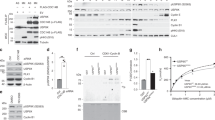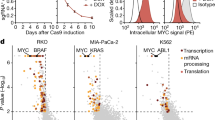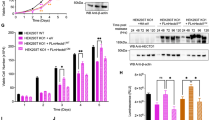Abstract
The eukaryotic cell cycle is regulated by sequential activation and inactivation of cyclin–cyclin-dependent kinase (Cdk) complexes. In this work, we screened human cDNAs that can rescue yeast Saccharomyces cerevisiae from lethality caused by ectopic expression of human cyclin E and isolated a cDNA encoding ESXR1, a paired-like homeodomain-containing protein with a unique C-terminal proline-rich repeat region. In adult tissues, ESXR1 is primarily expressed in the testis. We demonstrate that ESXR1 prevents degradation of ubiquitinated cyclins in human cells. Accordingly, elevation of ESXR1 level results in accumulation of cyclin A and cyclin B1 and thereby provokes M-phase arrest. In human cells, the 65-kDa full-length ESXR1 protein is capable of proteolytically processing into N-terminal 45-kDa and C-terminal 20-kDa fragments. The C-terminal fragment, containing a proline-rich repeat region, is localized to the cytoplasm and displays the ability to inhibit cyclin degradation. In contrast, the N-terminal fragment, containing a paired-like homeodomain, is localized exclusively in the nucleus, suggesting that it plays a role in transcription. Our results indicate that proteolytic processing of ESXR1 plays a role in concerted regulation of the cell cycle and transcription in human cells.
This is a preview of subscription content, access via your institution
Access options
Subscribe to this journal
Receive 50 print issues and online access
$259.00 per year
only $5.18 per issue
Buy this article
- Purchase on Springer Link
- Instant access to full article PDF
Prices may be subject to local taxes which are calculated during checkout











Similar content being viewed by others
References
Aberle H, Bauer A, Stappert J, Kispert A and Kemler R . (1997). EMBO J., 16, 3797–3804.
Ashizawa S, Nishizawa H, Yamada M, Higashi H, Kondo T, Ozawa H, Kakita A and Hatakeyama M . (2001). J. Biol. Chem., 276, 11362–11370.
Azam M, Lee C, Strehlow I and Schindler C . (1997). Immunity, 6, 691–701.
Brandeis M and Hunt T . (1996). EMBO J., 15, 5280–5289.
Branford WW, Zhao GQ, Valerius MT, Weinstein M, Birkenmeier EH, Rowe LB and Potter SS . (1997). Mech. Dev., 65, 87–98.
Chang DC, Xu N and Luo KQ . (2003). J. Biol. Chem., 278, 37865–37873.
den Elzen N and Pines J . (2001). J. Cell Biol., 153, 121–136.
DeSalle LM and Pagano M . (2001). FEBS Lett., 490, 179–189.
Dulic V, Lees E and Reed SI . (1992). Science, 257, 1958–1961.
D'Urso G, Marraccino RL, Marshak DR and Roberts JM . (1990). Science, 250, 786–791.
Featherstone C and Russell P . (1991). Nature, 349, 808–811.
Fohn LE and Behringer RR . (2001). Genomics, 74, 105–108.
Furuno N, den Elzen N and Pines J . (1999). J. Cell Biol., 147, 295–306.
Glotzer M, Murray AW and Kirschner MW . (1991). Nature, 349, 132–138.
Guadagno TM and Newport JW . (1996). Cell, 84, 73–82.
King RW, Deshaies RJ, Peters JM and Kirschner MW . (1996). Science, 274, 1652–1659.
Lew DJ, Dulic V and Reed SI . (1991). Cell, 66, 1197–1206.
Li Y, Lemaire P and Behringer RR . (1997). Dev. Biol., 188, 85–95.
Lundgren K, Walworth N, Booher R, Dembski M, Kirschner M and Beach D . (1991). Cell, 64, 1111–1122.
Millar JB, McGowan CH, Lenaers G, Jones R and Russell P . (1991). EMBO J., 10, 4301–4309.
Morgan DO . (1995). Nature, 374, 131–134.
Mumberg D, Müller R and Funk M . (1994). Nucleic Acids Res., 22, 5767–5768.
Naumann M, Nieters A, Hatada EN and Scheidereit C . (1993). Oncogene, 8, 2275–2281.
Ninomiya-Tsuji J, Nomoto S, Yasuda H, Reed SI and Matsumoto K . (1991). Proc. Natl. Acad. Sci. USA, 88, 9006–9010.
Nurse P . (2000). Cell, 100, 71–78.
Sette C, Barchi M, Bianchini A, Conti M, Rossi P and Geremia R . (1999). J. Biol. Chem., 274, 33571–33579.
Sherr CJ . (1994). Cell, 79, 551–555.
Solomon MJ, Glotzer M, Lee TH, Philippe M and Kirschner MW . (1990). Cell, 63, 1013–1024.
Su TT . (2001). Curr. Biol., 11, 467–469.
Tedesco D, Lukas J and Reed SI . (2002). Genes Dev., 16, 2946–2957.
Weinberg RA . (1995). Cell, 81, 323–330.
Yan YT, Stein SM, Ding J, Shen MM and Abate-Shen C . (2000). Mol. Cell. Biol., 20, 661–671.
Acknowledgements
We thank Dr Kunihiro Matsumoto and Dr Hideyoshi Yokosawa for cDNAs. We also thank Dr Chizuko Umehara and Takao Ueno for technical assistance. This work was supported by grants from the Human Frontier Science Program (HFSP), the Ministry of Education, Science, Sports, and Culture of Japan, and the Virtual Research Institute of Aging of Nippon Boehringer Ingelheim.
Author information
Authors and Affiliations
Corresponding author
Rights and permissions
About this article
Cite this article
Ozawa, H., Ashizawa, S., Naito, M. et al. Paired-like homeodomain protein ESXR1 possesses a cleavable C-terminal region that inhibits cyclin degradation. Oncogene 23, 6590–6602 (2004). https://doi.org/10.1038/sj.onc.1207884
Received:
Revised:
Accepted:
Published:
Issue Date:
DOI: https://doi.org/10.1038/sj.onc.1207884
Keywords
This article is cited by
-
aristaless1 has a dual role in appendage formation and wing color specification during butterfly development
BMC Biology (2023)
-
Association of ESX1 gene variants with non-obstructive azoospermia in Chinese males
Scientific Reports (2021)
-
Paired-like homeoprotein ESXR1 acts as a sequence-specific transcriptional repressor of the human K-ras gene
Oncogene (2005)



